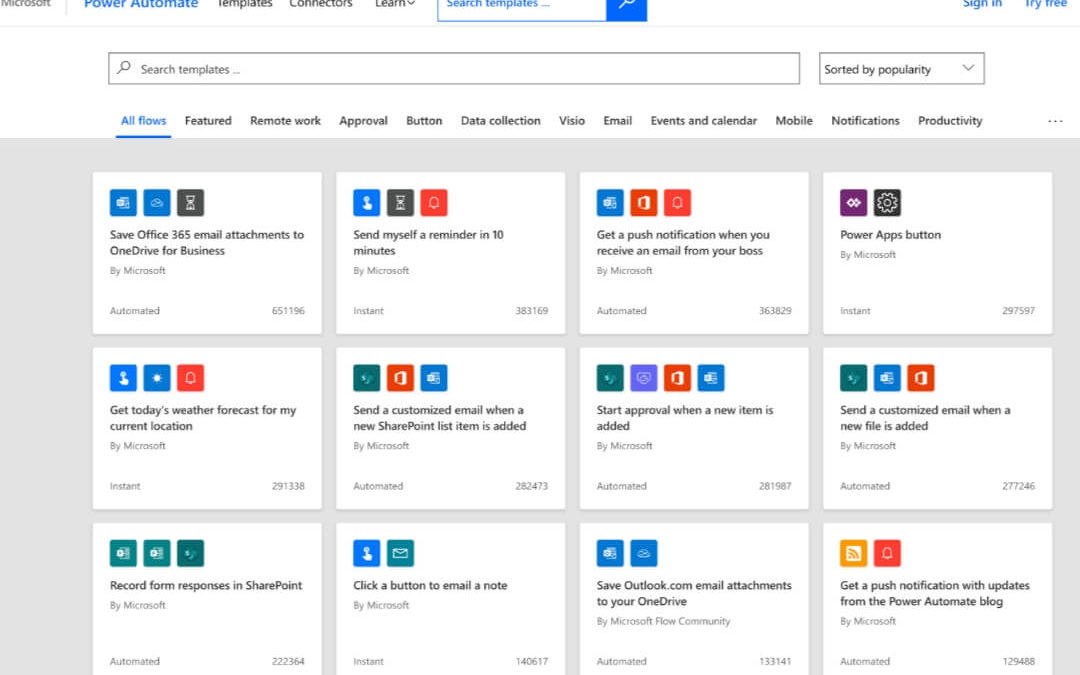Do you ever find that information is getting lost in communication in your business? Do messages and tasks slip through the cracks when things get busy? Do processes, that should take a matter of hours, stretch out to weeks while tasks languish in someone’s overfilled inbox? If any of this sounds familiar, you could benefit from Microsoft Flow. Read on to learn more about this program and the benefits it can bring to your business.
What is Microsoft Flow?
Microsoft Flow is a process and task automation tool that helps you connect different applications and services together. Many businesses choose to run Flow on the cloud, though it can also be used in an on-premises environment. This service comes available with some Office 365 bundles, but you can also get it on a separate subscription basis.
Microsoft Flow is a great option for teams that want to take advantage of process automation without having to sift through a lot of high-level technical jargon. It’s relatively easy to use, and everything is done through the browser. Some simple flows can even be done without the need for IT and developer involvement. This can speed up processes and improve your production time.
Actions and Events
To break it down to its most basic terms, you use Flow to define an action that’s triggered by an event. So if x happens, Flow will let you determine what the result will be. This may not sound very complicated, but when you start linking actions and events together, the results can become very sophisticated. Let’s say, for instance, that on a regular basis, you need to get Linda, Jack, Chandra, and Josie to all sign a form and send it on to someone in the finance department. When that form comes in (the event), Linda will get a notification reminding her to sign the form (action). When Linda signs the form, Jack will automatically get a notification, and so on and so forth until, at last, Josie signing the form triggers the action of the form being sent to the appropriate finance person.
Templates and Connectors
One of the things that makes Flow so easy to use is that the system comes stocked with pre-built templates and connectors. Think of these as pre-assembled pieces of the railway line you’re building. Rather than building the whole automation from the ground up, you can drop in a commonly used automation provided in the Flow system.
Templates can vary in function from getting an alert about the weather every day at noon and five to sending out alerts every time the boss schedules a new team meeting. You can set up weekly updates of new opportunities coming out of Salesforce or Microsoft Dynamics. And connectors allow you to hook up these templates to a wide variety of systems, including Salesforce, MailChimp, Facebook, and more.
How to Use Microsoft Flow
There are dozens of different ways you can use Flow to automate processes in your business. A good place to start looking at the opportunities this program provides is to sit down and take a look at all of your business processes. Where are people doing repetitive tasks that could be automated, and what’s getting delayed because it has to wait for a person to touch it?
You can use Flow to remind content owners and authors to keep data up to date on your intranet and policy library. You can provide your customers with updates about what’s happening with their call to a helpdesk. You can also monitor social media across multiple channels to keep your marketing engagement at its best.
Easy Integration
One of the main benefits of Microsoft Flow is how easy it is to integrate it into your existing system. Those connectors we talked about are extensive and simple to use. And Microsoft is constantly working to expand their library of connectors to make integration easier than ever. Your system likely uses a number of different programs, and Microsoft Flow can work with most, if not all, of them. You can set up automation patterns across multiple different platforms, taking more rote labor off your employees’ hands. This frees them up to focus on the important things: tasks that will grow your company and increase your bottom line.
Easy Access to Data
One of the biggest tools you have to help you grow your company is data. Strong data can tell you what you’re doing right, what you can improve on, what your customers need, and what you need to scrap. But many times, data silos can form in companies because of groups working across departments or platforms.
Microsoft Flow is a great tool for breaking up data silos. Because it has so many connectors and so much simple automation, you can make sure everyone has the data they need at their fingertips. In fact, you could set up an action that sends data out to all relevant parties as soon as it comes in.
Prioritize Tasks
Even with lots of automation, chances are good that your employees are going to wind up with more on their plate than they can handle at some point. During these times, having strong priorities can make sure your company keeps running smoothly. But how do you make sure nothing important slips through the cracks when you have so much going on? Microsoft Flow can help you set automatic prioritization of important tasks. You can designate some emails as high-priority and create a system where employees are reminded to do certain tasks before others. This way you make sure the essentials are getting done on time while less important tasks get pushed until later.
Learn More About Microsoft Flow
Microsoft Flow is a great tool for making sure your company is running as efficiently as possible. You can automate tasks on every level of your business, eliminating a lot of delays and ensuring that everyone has what they need at their fingertips. You can also make task management easier during busy seasons and make sure nothing slips through the cracks with your company.
If you’d like to discover the benefits of Microsoft Flow for your company, check out the rest of our site at IncWorx. We provide personalized Microsoft consulting and support to improve your team’s ability to collaborate, communicate, automate, and engage. Contact us today to get started increasing productivity, expanding expertise, and transforming your process.



